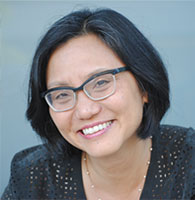Writing

Linda Sue Park
(photo by Sonya Sones)
I’ve decided to divide this page into two topics. All too often, people get “’writing” and “publishing” mixed up in their heads. Writing is a worthwhile endeavor for anyone who feels the impulse to put their thoughts on paper.
Getting published is a separate issue entirely, and folks who want to do both should never lose sight of that! Read my thoughts about “Getting Published.”
The Importance of Reading
Read. That’s the single best thing an aspiring writer can do for his or her work. I once heard an editor say, “Read a thousand books of the genre you’re interested in. THEN write yours.”
I was astonished and pleased to hear her say this—because that’s exactly what I did. During the years when I had no thought of writing for children (see Biography), I read and read and read. Middle-grade novels. Hundreds of them—easily more than a thousand. Then I wrote mine—and it sold on its first submission. Luck? Coincidence? Maybe … but I doubt it.
My personal reading list draws from a wide variety of genres. I love middle-grade novels best, but I also read Young Adult novels and picture books. I read adult literary fiction, mysteries, and nonfiction. I read poetry. I love books on food and travel. Whether a wondrous story or a hilarious passage of dialogue or a beautiful sentence or a memorable image, every bit of reading I do helps my own writing. The rhythm of language and the way words combine to communicate more than their dictionary meanings infuse the serious reader’s mind and emerge transformed when that reader sits down to write.
That’s really the best possible advice I could give any writer—read. But I find that folks are often disappointed with this advice, so I’ll offer a few more basic tips.
Writing is a highly personal, idiosyncratic endeavor. Advice that works for one writer may not work for another. Still, I love reading about how other writers work, and in doing so I found the two most important tools I use in my own writing. (Please note that these are probably more relevant for those who write novels or other longer works.)
Discipline
This tip I gleaned from author Katherine Paterson. Her books The Spying Heart and The Gates of Excellence are wonderful collections of essays on writing for children. Ms. Paterson explains that her method is to write two pages per day, every day. I adapted this as follows:
-
I write almost every day. On most of my writing days, I sit down at the keyboard in the morning and I don’t get up until I’ve written at least two pages.
-
Ms. Paterson doesn’t say if she means single- or double-spaced—so I decided on double-spacing! That’s about 500 words, which works well for me. Others may find a page count or an amount of time more useful. Still others write when the muse strikes them (but I’d be waiting until doomsday if I tried that approach). Find what works for you.
- On bad days, I might get 480 words written and throw them all away the next day. (My theory there is, I figure I’m getting all the awful stuff out of me …) On good days, two pages becomes twenty. But—and this is key—when I sit down to write I never know for sure which kind of day it’s going to become. I do my two pages no matter how crummy I feel about writing that day … and when I’m lucky, the act of writing itself turns the day into a good one.
Novel Structure
My outline for novel structure comes from author Lois Lowry (I’m a strong believer in learning from the best!). I read about how she builds her stories:
- Character
- Quest
- Complications and choices
- Climax
- Conclusion
- Change
Once again, I’ve adapted another writer’s advice to suit the way I work. I divide “Quest” into two sections: Internal and External. In every scene I write, the character must either make progress toward or face impediments to the quest(s). As a corollary, it follows that the greatest number of words is spent on “Complications and Choices.”
Here’s an example of how I used this outline when writing my first book, Seesaw Girl:
- Character: Jade Blossom, a 12-year-old girl, daughter of a wealthy family, living in 17th-century Korea. Extended family? Grandparents?
- Quest (external): To discover what lies beyond the walls of her home.
- Quest (internal): To find her place in a world that severely restricts the activities of girls and women.
- Complications and choices: Depiction of Inner Court life. Possible escape? Friendship with someone who leaves home? Sees French missionaries on the road. Wants to paint what she has seen. Second escape?
- Climax: Idea for seesaw
- Conclusion: Sacrifice (what?) to accomplish goal.
- Change: character growth, but how? acceptance?
As you can see, it’s quite a rough outline and it’s also the full extent of my planning before I begin writing; a detailed chapter-by-chapter plan doesn’t work for me. I find the act of writing itself triggers creativity, and I want to leave myself lots of room to follow the story where it goes as I’m writing it.
The final version of the manuscript differs in several ways from this initial outline, especially the “Complications and Choices,” but using it as a blueprint keeps me from wandering too far off track.
What I like best about Ms. Lowry’s outline is that there is NO step labeled “Theme.” I think she believes as I do: That theme should grow out of the character and the story. If a writer begins with theme, the story is likely to be heavy-handed and messagey … the kind of book kids run away from. And I’m running right beside them!
